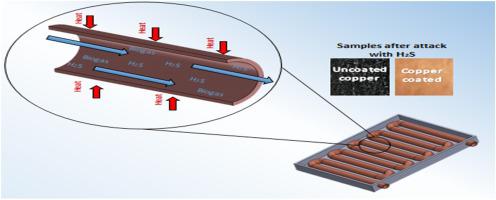当前位置:
X-MOL 学术
›
Prog. Org. Coat.
›
论文详情
Our official English website, www.x-mol.net, welcomes your
feedback! (Note: you will need to create a separate account there.)
Improvement of the anticorrosive and thermal properties of an Epoxy-SiO2 coating due to the presence of silicon nitride
Progress in Organic Coatings ( IF 6.5 ) Pub Date : 2020-10-01 , DOI: 10.1016/j.porgcoat.2020.105735 Jorge Luis Gómez-Magallón , J. Alejandro Menchaca-Rivera , Jorge Pineda-Piñón , Luz Ma. Avilés-Arellano , Alejandra García-García , Juan Francisco Pérez Robles
Progress in Organic Coatings ( IF 6.5 ) Pub Date : 2020-10-01 , DOI: 10.1016/j.porgcoat.2020.105735 Jorge Luis Gómez-Magallón , J. Alejandro Menchaca-Rivera , Jorge Pineda-Piñón , Luz Ma. Avilés-Arellano , Alejandra García-García , Juan Francisco Pérez Robles

|
Abstract In recent years there has been a significant boom in the production of biofuels, especially biomethane, through anaerobic biodigestion, but when the substrates decompose inside the reactors, they generate hydrogen sulfide, H2S as a byproduct. On the other hand, to increase the efficiency of biodigesters it is necessary to have control of temperature. Based on our experience, one of the ways to achieve that control is to take the gas from the upper part of the reactor, pass it through a solar heat exchanger, and then inject the hot gas in the bottom of the reactor. However, gas recirculation results in corrosion of copper pipes due to the high hydrogen sulfide, H2S content of the gas stream from the reactor. For the reasons mentioned, a hybrid epoxy resin-silica coating was designed in this work that protects the copper surface against corrosion by H2S and at the same time withstands moderate temperatures. The coatings were obtained from three v/w ratios of TEOS / Resin (T/R): 0.64, 1.28 and 1.92, named as R1, R2 and R3 respectively. Silica was produced in situ by the Sol-Gel process. The coatings on copper substrates were obtained by dip-coating, annealed at 75 °C and treated at different temperatures for evaluating their resistance to temperature. The corrosion resistance of coatings to H2S was evaluated through ASTM D610−01 and ASTM D714−02 Standards. The structural characterization of the coatings was performed by FTIR, Streaming Potential, SEM and XPS. The R2 hybrid coating showed excellent resistance to temperature and H2S attack. From all the characterization carried out and taking into account the literature review, it is concluded that the Si-N bonds obtained via sol-gel in situ at relatively low temperatures (75 °C) contribute to the protection of copper foils against the effect of temperatures higher than 100 °C and to the protection of corrosion by H2S. Taking the R2 formulation, further experimentation will be carried out for coating the internal part of copper pipes of a solar heat exchanger prototype.
中文翻译:

由于氮化硅的存在,Epoxy-SiO2 涂层的防腐和热性能得到改善
摘要 近年来,通过厌氧生物消化生产生物燃料,特别是生物甲烷,出现了显着的繁荣,但当底物在反应器内分解时,它们会生成硫化氢,副产物 H2S。另一方面,为了提高生物消化器的效率,必须控制温度。根据我们的经验,实现这种控制的方法之一是从反应器上部取出气体,通过太阳能热交换器,然后将热气体注入反应器底部。然而,由于来自反应器的气流中硫化氢、H2S 含量高,气体再循环会导致铜管腐蚀。由于上述原因,在这项工作中设计了一种混合环氧树脂 - 二氧化硅涂层,可保护铜表面免受 H2S 腐蚀,同时承受中等温度。涂层是从三个 V/W 比率的 TEOS/树脂 (T/R) 中获得的:0.64、1.28 和 1.92,分别命名为 R1、R2 和 R3。二氧化硅是通过溶胶-凝胶工艺原位生产的。铜基板上的涂层通过浸涂获得,在 75°C 下退火,并在不同温度下进行处理,以评估其耐温性。涂层对 H2S 的耐腐蚀性通过 ASTM D610-01 和 ASTM D714-02 标准进行评估。涂层的结构表征是通过 FTIR、流电势、SEM 和 XPS 进行的。R2 混合涂层表现出出色的耐热性和 H2S 侵蚀性。从所进行的所有表征并考虑到文献综述,得出的结论是,在相对较低的温度 (75 °C) 下通过溶胶-凝胶原位获得的 Si-N 键有助于保护铜箔免受温度高于 100 °C 并通过 H2S 保护腐蚀。采用 R2 配方,将进行进一步的实验,以涂覆太阳能热交换器原型的铜管内部。
更新日期:2020-10-01
中文翻译:

由于氮化硅的存在,Epoxy-SiO2 涂层的防腐和热性能得到改善
摘要 近年来,通过厌氧生物消化生产生物燃料,特别是生物甲烷,出现了显着的繁荣,但当底物在反应器内分解时,它们会生成硫化氢,副产物 H2S。另一方面,为了提高生物消化器的效率,必须控制温度。根据我们的经验,实现这种控制的方法之一是从反应器上部取出气体,通过太阳能热交换器,然后将热气体注入反应器底部。然而,由于来自反应器的气流中硫化氢、H2S 含量高,气体再循环会导致铜管腐蚀。由于上述原因,在这项工作中设计了一种混合环氧树脂 - 二氧化硅涂层,可保护铜表面免受 H2S 腐蚀,同时承受中等温度。涂层是从三个 V/W 比率的 TEOS/树脂 (T/R) 中获得的:0.64、1.28 和 1.92,分别命名为 R1、R2 和 R3。二氧化硅是通过溶胶-凝胶工艺原位生产的。铜基板上的涂层通过浸涂获得,在 75°C 下退火,并在不同温度下进行处理,以评估其耐温性。涂层对 H2S 的耐腐蚀性通过 ASTM D610-01 和 ASTM D714-02 标准进行评估。涂层的结构表征是通过 FTIR、流电势、SEM 和 XPS 进行的。R2 混合涂层表现出出色的耐热性和 H2S 侵蚀性。从所进行的所有表征并考虑到文献综述,得出的结论是,在相对较低的温度 (75 °C) 下通过溶胶-凝胶原位获得的 Si-N 键有助于保护铜箔免受温度高于 100 °C 并通过 H2S 保护腐蚀。采用 R2 配方,将进行进一步的实验,以涂覆太阳能热交换器原型的铜管内部。











































 京公网安备 11010802027423号
京公网安备 11010802027423号